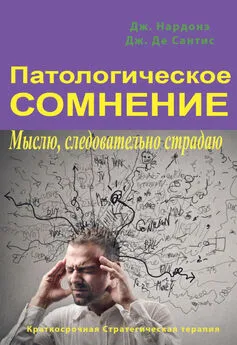Джорджио Нардонэ - Страх, паника, фобия. Краткосрочная терапия
- Название:Страх, паника, фобия. Краткосрочная терапия
- Автор:
- Жанр:
- Издательство:Психотерапия
- Год:2008
- Город:Москва
- ISBN:978-5-903182-48-0
- Рейтинг:
- Избранное:Добавить в избранное
-
Отзывы:
-
Ваша оценка:
Джорджио Нардонэ - Страх, паника, фобия. Краткосрочная терапия краткое содержание
Книга предназначена для специалистов-психотерапевтов, психологов и медиков, для студентов означенных специальностей. Она также адресована тем, кто интересуется, как возникают и разрешаются человеческие проблемы.
Страх, паника, фобия. Краткосрочная терапия - читать онлайн бесплатно ознакомительный отрывок
Интервал:
Закладка:
П.: Между прочим, я даже купил кольцо.
Т.: Кольцо для помолвки.
П.: Да, французского типа.
Т.: Ты будешь хранить его?
П.: Конечно. Я влюблен в эту девушку, мы вместе уже три месяца, это не очень длительный срок, однако…
Т.: Именно качество имеет значение, а не количество времени, которое люди вместе. Вы — хорошая пара. Ну, дорогой друг, увидимся в сентябре. Если тебе что-то понадобится, я здесь, но если не будет никакой необходимости… Следовательно, мы встречаемся, снова через шесть месяцев. И помни, что за тобой пять процентов. И так как мы не будем встречаться, то я бы хотел, чтобы ты мне звонил каждые пятнадцать-двадцать дней, чтобы сообщить мне, как идут дела; я бы хотел получить информацию о том, сколько времени тебе понадобится, чтобы избавиться от тех пяти процентов.
П.: Но выдумаете… то есть, зависит от меня, когда эта терапия закончится? Потому что я действительно не могу дождаться, когда она закончится. Мне жаль, что я не смогу вас больше увидеть, потому что я к вам привязался… однако, скажем, что и из-за того, что я себя хорошо чувствую… и тогда…
Т.: Для меня, М., терапия завершена. Я буду только контролировать результаты.
П.: О, она уже завершена???
Т.: Осталось только сделать так, чтобы ты продолжал идти вперед, но с энтузиазмом.
П.: То есть дело теперь только за мной?… Доктор, я бы хотел попросить вас об одном одолжении. В свое время моя мама пообещала мне, что как только я поправлюсь, моя бабушка по материнской линии подарит мне мотоцикл. Я всегда хотел мотоцикл. Если бы вы могли… я не знаю… дать мне бумагу, что я уже поправился.
Т.: В сентябре.
П.: В сентябре? О.К.
Библиография
Amerio, P. (1982). Teoiie in psichologia sociale, Bologna, II Mulino.
Andolfi, M. (1991). «Tre generazioni in terapia» in Malagoli-Togliatti, M. and Telfener, U. (eds.) Dallʼindividuo al sistema, Torino, Boringhieri.
Andrews, G. and Harvey, R. (1981). «Does Psychotherapy Benefit Neurotic Patients? A Reanalysis of the Smith, Glass and Miller Data» in Archivesof General Psychiatry, 38, 1203–1208.
Ashby, W.R. (1954). Design for a Brain. New York, Wiley.
Ashby, W.R. (1956). An Introduction to Cybernetics. London, Methuen.
Austin, J.L. (1962). How to Do Things with Words. Cambridge, Harvard University Press.
Avnet, H.H. (1965). How Effective Is Short-Term Therapy? in L. R. Wolberg (ed.), Short-Tetm Psychotherapy. New York, Grune and Stratton.
Bandler, R. and Grinder, J. (1975a). Patterns of the Hypnotic Tecnique of Milton J. Erickson, M.D., Palo Alto, Calif:, Meta Publications.
Bandler, R. and Grinder, J. (1975b). The Structure of Magic. Palo Alto, Calif., Meta Publications.
Bandura (1974). Psychological Modeling. Chicago, Aldine.
Bandura (1977). Social Learning Theory. Englewood Cliff, Prentice Hall.
Bannister, D. and Fransella, F. (1977). Inquiring Man: The Theory of Personal Constructs, Hamondsworth, England, Penguin.
Bateson, G. (1972). Cybernetic Explanation. In American Behavioural Scientist, 10, 29–32.
Bateson, G. (1979). Mind and Nature. New York, Ballantine Books.
Bateson, G. and Jackson, D.D. (1964). «Some Varieties of Pathogenic Organization» in Disorders of Communication, (Research Publications, Association for Research in Nervous and Mental Disease), 42, 270–283.
Bateson, G., Jackson, D.D., Haley J. and Weakland, J.H. (1956). «Toward a Theory of Schizophrenia». Behavioural Sciences, 1,251–264.
Beck, A.T. and Emery, G. (1985). Anxiety Disorders and Phobia. New York, Basic Books.
Bergin, A.E., and Strupp, H.H. (1972). Changing Frontiers in the Sciences of Psychotherapy. Chicago, Aldine.
Bergin, A.E. and Lambert, M.J. (1978). «The Evaluation of Therapeutic Outcomes» in Garfield, S.L. and Bergin, A.E. (eds.), Handbook of Psychotherapy and Behavior Change, Second edition, New York, Wiley.
Bergman, J.S. (1985). Fishing for Barracuda: Pragmatics of Brief Systemic Therapy, New York, Norton.
Birdwhistel, R. (1970). «Meta-communicational Thoughts: About Communication Studies» in Jakin et al., A language , The Hague, Molton.
Bloch, A. (1989). La Legge di Murphy e altri motivi per cuile cosc vanno arovescia, Milano, Longanesi.
Bodin, A. (1980). «The Interactional View: Family Theraphy Approaches of The Mental Research Institute» in Gurman, A.S. and Kniskern, D.P. (eds.) The Handbook of Family Therapy. New York, Brunner/ Mazel.
Boscolo, L., Cecchin, G., Hoofman, L. and Penn, P. (1988). Milan Systemic Family Therapy. New York, Basic Books.
Bourn, E.J. (1990). The Anxiety and Phobia Workbook. Oakland, Calif., New Harlinger Publications Inc.
Brown, G.S. (1973). Laws of Form. New York, Bantam Books.
Butcher, J.N. and Koss, M.P. (1978). «М. М. Р. L. Research on Brief and Crisis-Oriented Therapies», in Garfield, S.L., and Bergin, A.E. (eds.), The Handbook of Psychotherapy and Behavior Change, Second edition. New York, Wiley and Sons.
Cancrini, L. (1987). Psicoterapia: Sintassi e Grammatica. Rome, Italy, La Nuova Italia.
Ceronetti, G. (1987). Pensieri de te. Milan, Italy, Adelphi.
Chambers, G.S. and Hamlin, R. (1957). «The Validity of Judgements based on „Blind“ Roschach Records» in Journal of Consulting Psycology, 21,105–109.
Cialdini, R.B. (1984). How and Why People Agree to Things. New York, William Morrow.
DeShazar, S. (1982). Patterns of Brief Therapy. NewYork, Guilford.
DeShazar, S. (1985). Keys to Solution in Brief Therapy. NewYork, W. W. Norton and Co.
Diagnostic and Statistical Manual of Mental'Disorders (1987) 3-rd revised edition, American Psychiatric Association.
Eigen, M. (1986). Ilgioco. Milano, Adelphi.
Ellis (1981). «TeoriaePrassi della RET» in Guidano, Reda (eds.) Cognitivismo e Psicoterapia. Milano, Angeli.
Elster, J. (1979). Ulysses and the Sirens. Cambridge, Cambridge University Press.
Erickson, М.H., Rossi, E.L. (eds.) (1982). The Collected Papers of Milton H. Erickson on Hypnosis, 4 vols., New York, Irvington.
Erickson, M.H., Rossi, E.L. and Rossi, S.I. (1979). Hypnotic Realities: The Induction of Clinical Hypnosis and Forms of Indirect Suggestion. New York, Irvington.
Fisch, R., Weakland, J.H., Watzlawick, P., Segal, L., Hoebel, F., and Deardoff, M. (1975). Learning Brief Therapy: an Introductory Training Manual. Palo Alto, Calif., Mental Research Institute.
Fisch, R., Weakland, J.H., Segal, L. (1982a). The Tactics of Change, San Francisco, Jossey-Bass.
Fisch, R., Watzlawick, P., Weakland, J.H. and Bodin, A. (1982b). «On Unbecoming Family Therapists» in Ferber, A., Mendelson, М., and Napier, A. (eds.) The Book Family Therapy, New York, Science House.
Foerster, H. von (1970). «Thoughts and Notes on Cognition», in Garvin, P.L., (ed.) Cognition: A Multiple View, New York, Plenum, 25–48.
Foerster, H. von (1984). «On Constructing a Reality» in Watzlawick, P., The Invented Reality, New York, Norton.
Foerster, H. von (1974). «Kybernetik einer Erkennthistorie» (Cybernetic Epistemology), in Keidel,W. D. Handler, W., and Spring, M. (eds) Kybernetik undBionik, (Cybernetics and Bionics), Munich, Oldenburg.
Foerster, H. von (1987). Sistemichesi osservano, Roma, Astrolabio.
Frank, J.D. (1971). «Therapeutic Components of Psychotherapy. A 25-year Progress Report of Research» in Journal of Consulting Clinical Psychology, 37, 307–313.
Frankl, V.E. (1960). «Paradoxical Intention», American Journal of Psychotherapy, 14, 520–535.
Galli (ed.) (1987 ). AntologiadiScritti: Lewin. Bologna, IlMulino.
Garfield, S.L. (1981). Psychotherapy: An Eclectic Approach. New York, Wiley.
Garfield, S.L. (1981). «Psychotherapy: a 40-Year Appraisal» in American Psychologist, 2, 174–183.
Garfield, S.L., Prager, R.A., and Bergin, A.E., (1971). «Evaluation of Outcome in Psychotherapy» in Journal of Consulting Clinical Psychology, 37, 307–313.
Garfield, S.L. (1989). The Practice of Brief Psychotherapy. New York, Pergamon Press.
Giannattasio, E. and Nencini, R. (1983). Conoscenza e modellazione nella psicologia. Roma, La Goliardica.
Giles, T.R. (1983). «Probable Superiority of Behavioral Interventions: I: Traditional Comparative Outcome» in Journal of Behavioral Therapy Experimental Psychiatry, 14,29–32.
Glaserfeld, E. von (1979). «Cybernetic Experience and Concept of Self» in Ozer, M.N., (ed.) A Cybernetic Approach to Assessment of Children: Towards More Human Use of Human Beings, Boulder, Colo, Westview Press.
Glaserfeld, E. von (1979). «AnIntroduction to Radical Constructivism» in Watzlawick, P. The Invented Reality. New York, Norton.
Goethe, J.W. (1983). Massime eRiflessioni. Roma, Theoria.
Goldwurm, G. etal. (1986 ).Tecnichedirilassamentonella terapiacomportamentale. Milano, Angeli.
Grecian, B. (1967). Oracolomanuale e arte di prudenza. Milano, Rizzoli.
Greenberg, G. (1980). «Problem-Focused Brief Family Interactional Psychotherapy» in Lewis, R., Wolberg, M.D., Marvin, L. and Aronson, P.D. (eds.), Groups and Family Therapy. New York, Brunner/ Mazel.
Guastafson, J.P. (1986). The Complex Secret of Brief Psychotherapy. New York, Norton.
Guidano, V. (1988). La Complessita delse. Torino, Boringhieri.
Gurman, A.S. and Kniskern, D.P. (1978). «Research on Marital and Family Therapy» in Garfield, S.L., and Bergin, A.E. (eds.), The Handbook of Psychotherapy and Behavior Change, Second edition, New York, Wiley.
Haley, J. (1967). Advanced Techniques of Hypnosis and Theraphy: Selected Papers of Milton J. Erickson, M.D., New York/London, Grune and Stratton.
Haley, J. (1976). Uncommon Theraphy: the Psychiatric Techniques of Milton J. Erickson, M.D. New York, Norton.
Haley, J. (1976). Problem-Solving Therapy. San Francisco, Calif., Jossey-Bass.
Читать дальшеИнтервал:
Закладка:


![Джорджио Нардонэ - Психологические ловушки. Как мы создаём то, от чего потом страдаем [litres]](/books/1068178/dzhordzhio-nardone-psihologicheskie-lovushki-kak-my-s.webp)







